Understanding Taxation: Difference between Employment and Self-Employment, Tax Avoidance and Tax Evasion, Purpose and Types of Taxation in UK
VerifiedAdded on 2023/06/10
|11
|2817
|481
AI Summary
The present study is based on understanding the difference between the employment and self-employment. The study would critically carry out the discussion of differentiating between the employment and self-employment. Furthermore, a critical evaluation of the tax avoidance and tax evasion would be studied along with their implications on the clients and government. An assessment of purpose and forms of taxation practiced in UK would also be considered with tax planning issues for the government and the clients.
Contribute Materials
Your contribution can guide someone’s learning journey. Share your
documents today.
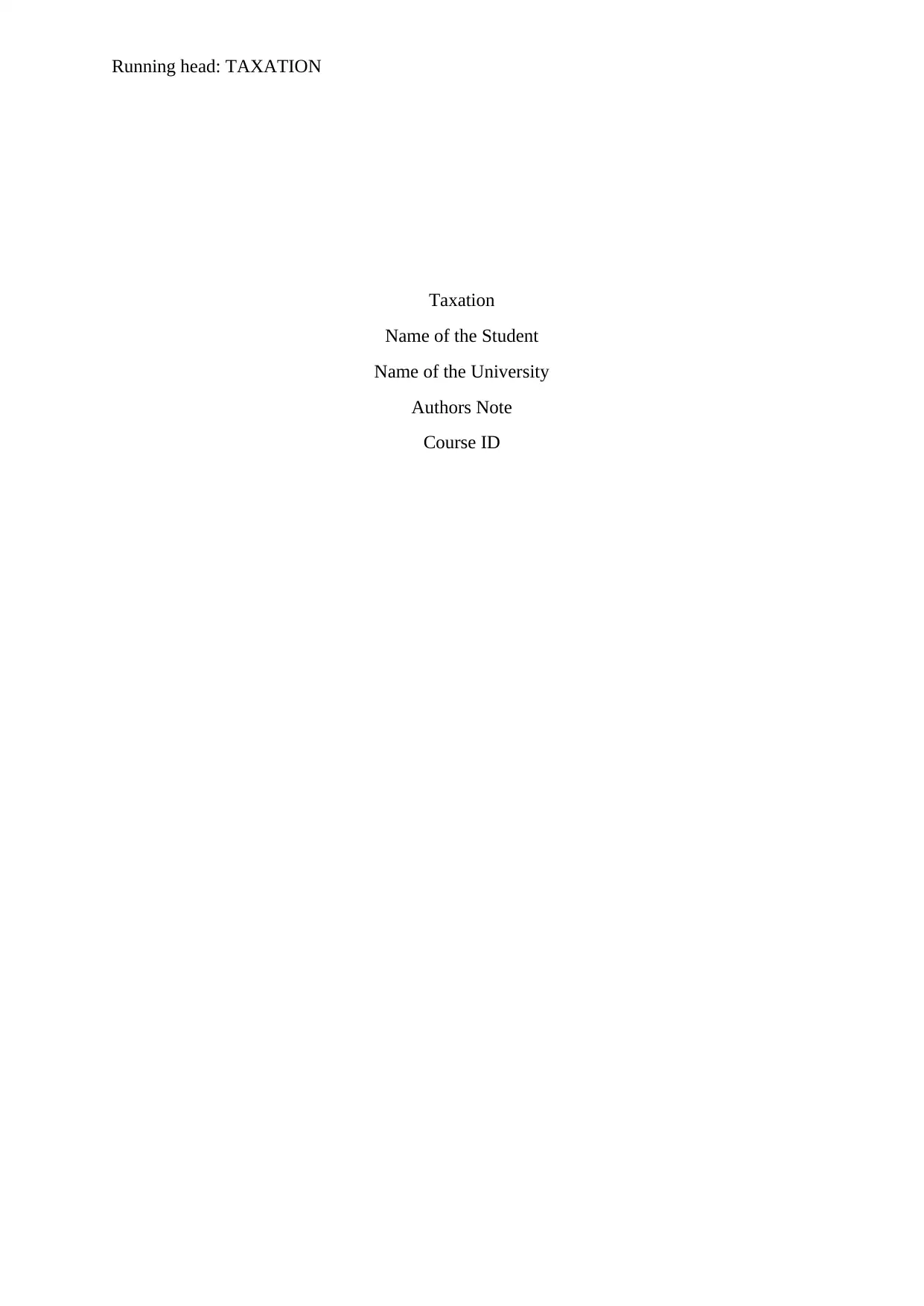
Running head: TAXATION
Taxation
Name of the Student
Name of the University
Authors Note
Course ID
Taxation
Name of the Student
Name of the University
Authors Note
Course ID
Secure Best Marks with AI Grader
Need help grading? Try our AI Grader for instant feedback on your assignments.
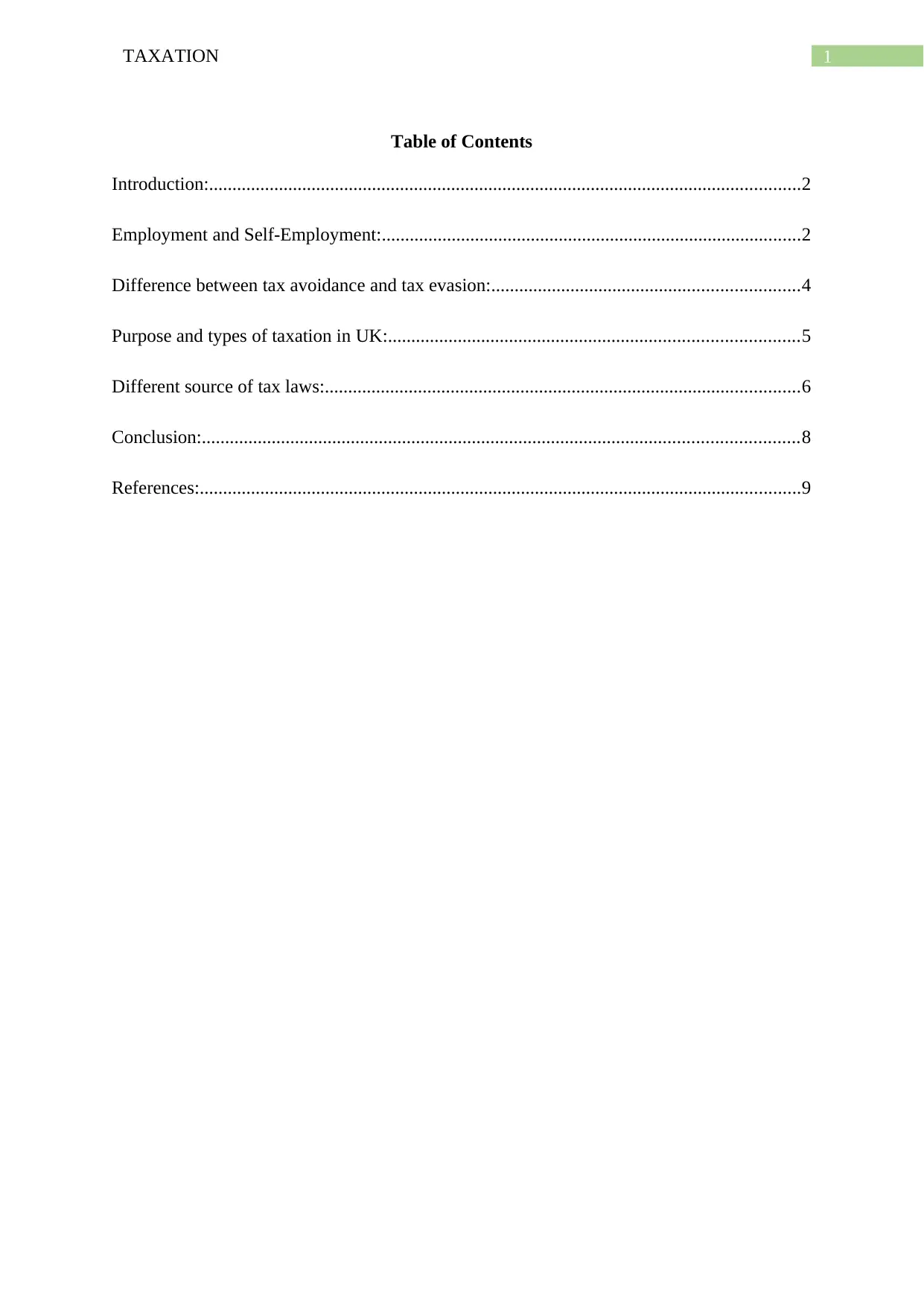
1TAXATION
Table of Contents
Introduction:...............................................................................................................................2
Employment and Self-Employment:..........................................................................................2
Difference between tax avoidance and tax evasion:..................................................................4
Purpose and types of taxation in UK:........................................................................................5
Different source of tax laws:......................................................................................................6
Conclusion:................................................................................................................................8
References:.................................................................................................................................9
Table of Contents
Introduction:...............................................................................................................................2
Employment and Self-Employment:..........................................................................................2
Difference between tax avoidance and tax evasion:..................................................................4
Purpose and types of taxation in UK:........................................................................................5
Different source of tax laws:......................................................................................................6
Conclusion:................................................................................................................................8
References:.................................................................................................................................9
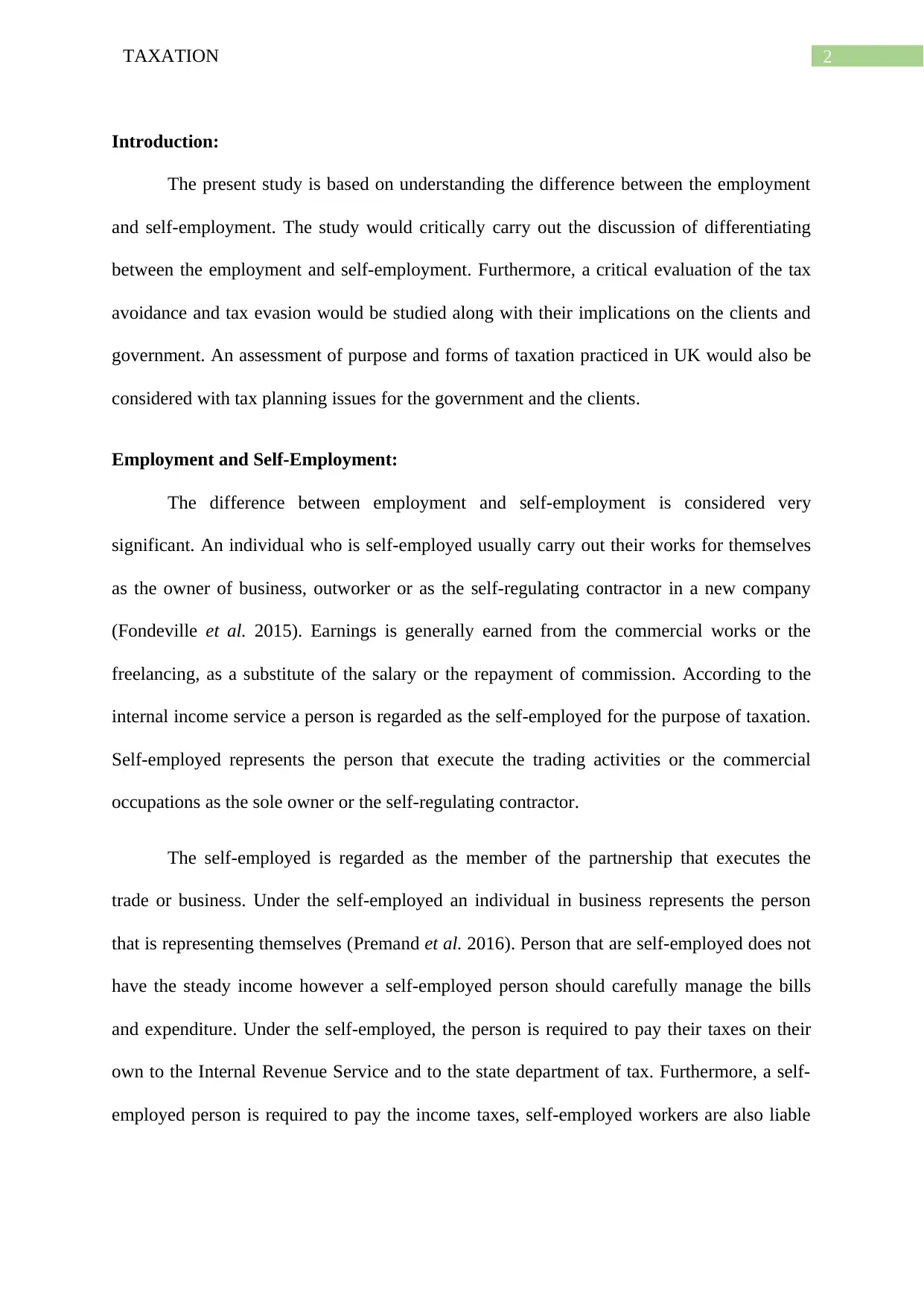
2TAXATION
Introduction:
The present study is based on understanding the difference between the employment
and self-employment. The study would critically carry out the discussion of differentiating
between the employment and self-employment. Furthermore, a critical evaluation of the tax
avoidance and tax evasion would be studied along with their implications on the clients and
government. An assessment of purpose and forms of taxation practiced in UK would also be
considered with tax planning issues for the government and the clients.
Employment and Self-Employment:
The difference between employment and self-employment is considered very
significant. An individual who is self-employed usually carry out their works for themselves
as the owner of business, outworker or as the self-regulating contractor in a new company
(Fondeville et al. 2015). Earnings is generally earned from the commercial works or the
freelancing, as a substitute of the salary or the repayment of commission. According to the
internal income service a person is regarded as the self-employed for the purpose of taxation.
Self-employed represents the person that execute the trading activities or the commercial
occupations as the sole owner or the self-regulating contractor.
The self-employed is regarded as the member of the partnership that executes the
trade or business. Under the self-employed an individual in business represents the person
that is representing themselves (Premand et al. 2016). Person that are self-employed does not
have the steady income however a self-employed person should carefully manage the bills
and expenditure. Under the self-employed, the person is required to pay their taxes on their
own to the Internal Revenue Service and to the state department of tax. Furthermore, a self-
employed person is required to pay the income taxes, self-employed workers are also liable
Introduction:
The present study is based on understanding the difference between the employment
and self-employment. The study would critically carry out the discussion of differentiating
between the employment and self-employment. Furthermore, a critical evaluation of the tax
avoidance and tax evasion would be studied along with their implications on the clients and
government. An assessment of purpose and forms of taxation practiced in UK would also be
considered with tax planning issues for the government and the clients.
Employment and Self-Employment:
The difference between employment and self-employment is considered very
significant. An individual who is self-employed usually carry out their works for themselves
as the owner of business, outworker or as the self-regulating contractor in a new company
(Fondeville et al. 2015). Earnings is generally earned from the commercial works or the
freelancing, as a substitute of the salary or the repayment of commission. According to the
internal income service a person is regarded as the self-employed for the purpose of taxation.
Self-employed represents the person that execute the trading activities or the commercial
occupations as the sole owner or the self-regulating contractor.
The self-employed is regarded as the member of the partnership that executes the
trade or business. Under the self-employed an individual in business represents the person
that is representing themselves (Premand et al. 2016). Person that are self-employed does not
have the steady income however a self-employed person should carefully manage the bills
and expenditure. Under the self-employed, the person is required to pay their taxes on their
own to the Internal Revenue Service and to the state department of tax. Furthermore, a self-
employed person is required to pay the income taxes, self-employed workers are also liable
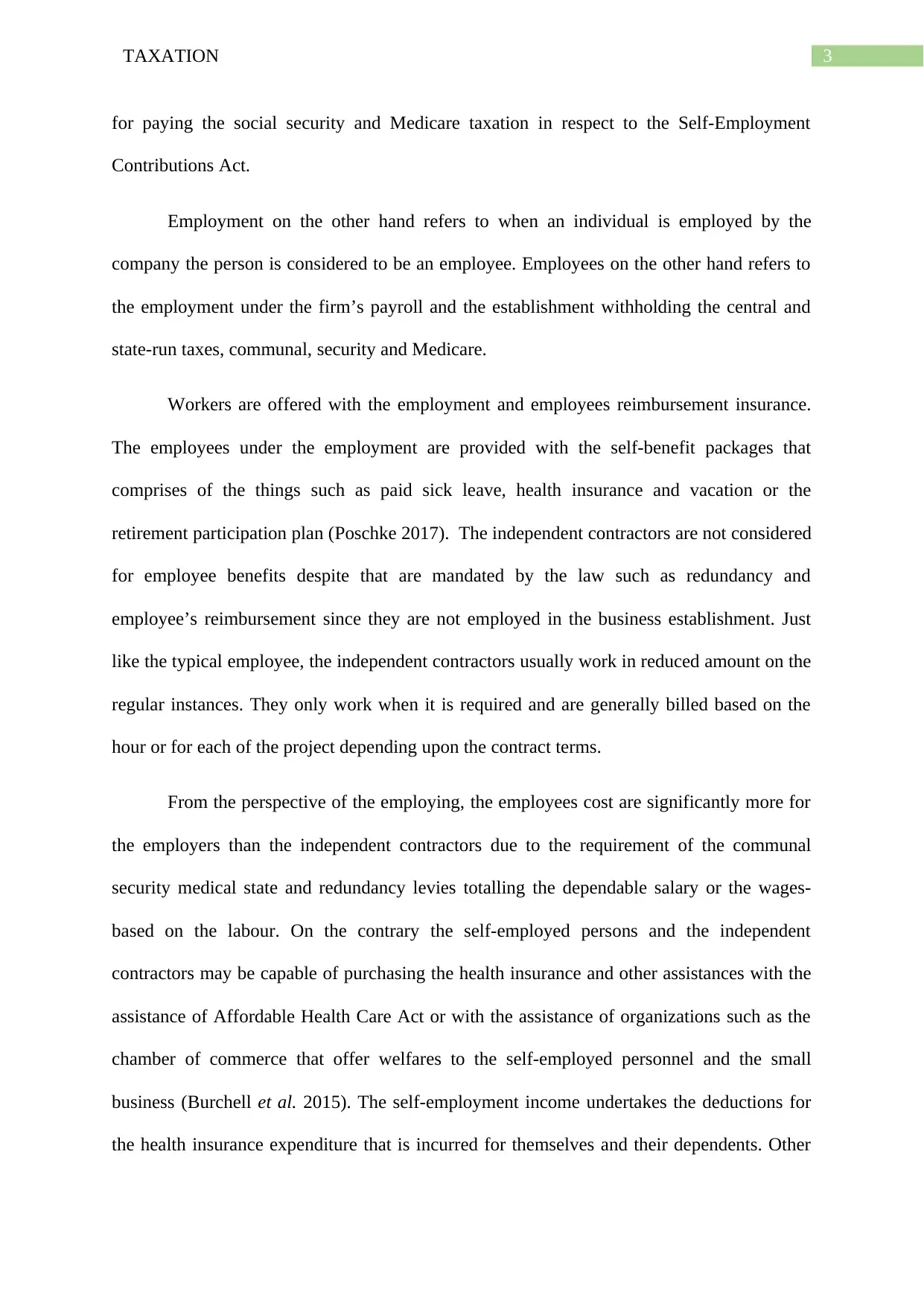
3TAXATION
for paying the social security and Medicare taxation in respect to the Self-Employment
Contributions Act.
Employment on the other hand refers to when an individual is employed by the
company the person is considered to be an employee. Employees on the other hand refers to
the employment under the firm’s payroll and the establishment withholding the central and
state-run taxes, communal, security and Medicare.
Workers are offered with the employment and employees reimbursement insurance.
The employees under the employment are provided with the self-benefit packages that
comprises of the things such as paid sick leave, health insurance and vacation or the
retirement participation plan (Poschke 2017). The independent contractors are not considered
for employee benefits despite that are mandated by the law such as redundancy and
employee’s reimbursement since they are not employed in the business establishment. Just
like the typical employee, the independent contractors usually work in reduced amount on the
regular instances. They only work when it is required and are generally billed based on the
hour or for each of the project depending upon the contract terms.
From the perspective of the employing, the employees cost are significantly more for
the employers than the independent contractors due to the requirement of the communal
security medical state and redundancy levies totalling the dependable salary or the wages-
based on the labour. On the contrary the self-employed persons and the independent
contractors may be capable of purchasing the health insurance and other assistances with the
assistance of Affordable Health Care Act or with the assistance of organizations such as the
chamber of commerce that offer welfares to the self-employed personnel and the small
business (Burchell et al. 2015). The self-employment income undertakes the deductions for
the health insurance expenditure that is incurred for themselves and their dependents. Other
for paying the social security and Medicare taxation in respect to the Self-Employment
Contributions Act.
Employment on the other hand refers to when an individual is employed by the
company the person is considered to be an employee. Employees on the other hand refers to
the employment under the firm’s payroll and the establishment withholding the central and
state-run taxes, communal, security and Medicare.
Workers are offered with the employment and employees reimbursement insurance.
The employees under the employment are provided with the self-benefit packages that
comprises of the things such as paid sick leave, health insurance and vacation or the
retirement participation plan (Poschke 2017). The independent contractors are not considered
for employee benefits despite that are mandated by the law such as redundancy and
employee’s reimbursement since they are not employed in the business establishment. Just
like the typical employee, the independent contractors usually work in reduced amount on the
regular instances. They only work when it is required and are generally billed based on the
hour or for each of the project depending upon the contract terms.
From the perspective of the employing, the employees cost are significantly more for
the employers than the independent contractors due to the requirement of the communal
security medical state and redundancy levies totalling the dependable salary or the wages-
based on the labour. On the contrary the self-employed persons and the independent
contractors may be capable of purchasing the health insurance and other assistances with the
assistance of Affordable Health Care Act or with the assistance of organizations such as the
chamber of commerce that offer welfares to the self-employed personnel and the small
business (Burchell et al. 2015). The self-employment income undertakes the deductions for
the health insurance expenditure that is incurred for themselves and their dependents. Other
Secure Best Marks with AI Grader
Need help grading? Try our AI Grader for instant feedback on your assignments.
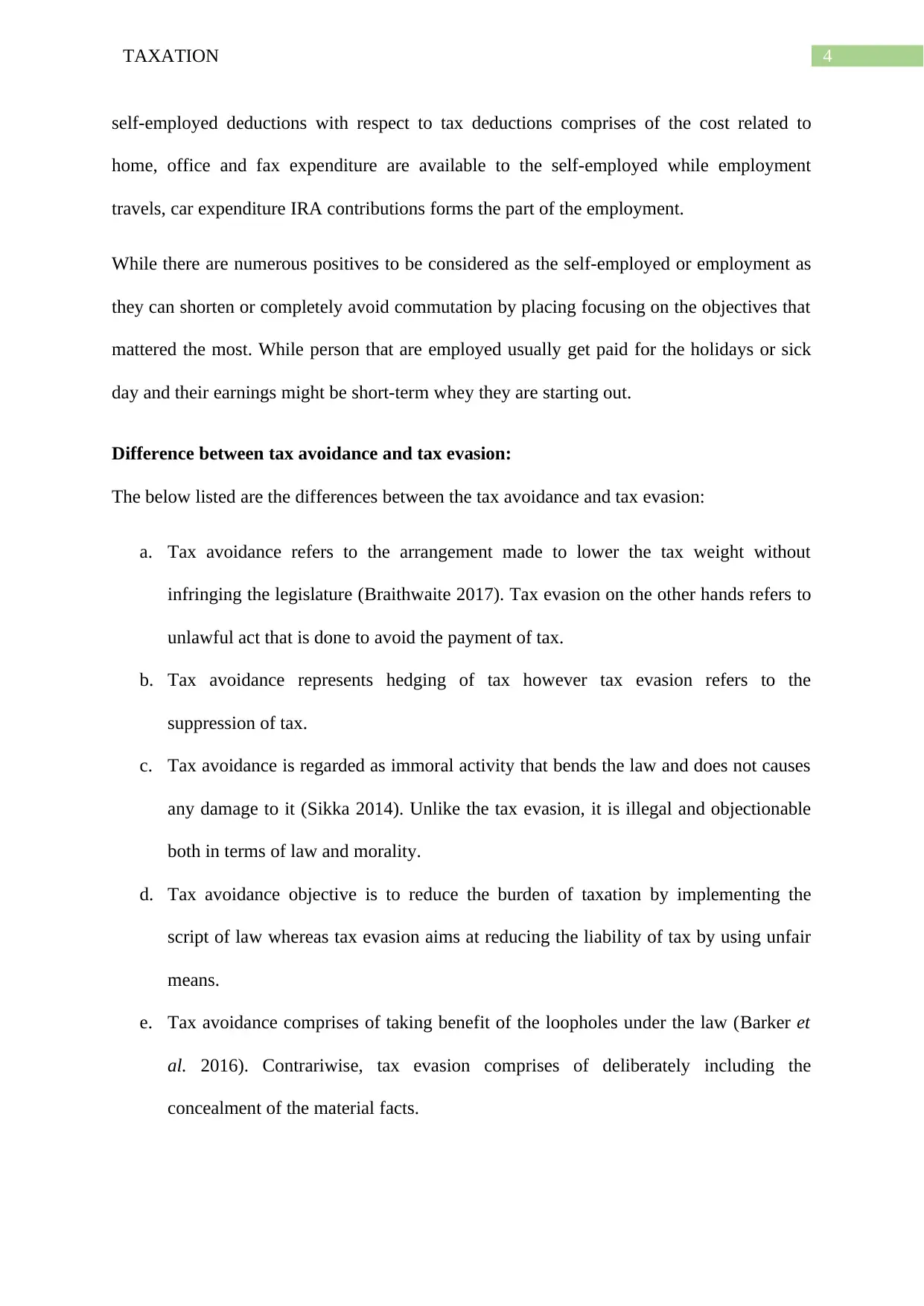
4TAXATION
self-employed deductions with respect to tax deductions comprises of the cost related to
home, office and fax expenditure are available to the self-employed while employment
travels, car expenditure IRA contributions forms the part of the employment.
While there are numerous positives to be considered as the self-employed or employment as
they can shorten or completely avoid commutation by placing focusing on the objectives that
mattered the most. While person that are employed usually get paid for the holidays or sick
day and their earnings might be short-term whey they are starting out.
Difference between tax avoidance and tax evasion:
The below listed are the differences between the tax avoidance and tax evasion:
a. Tax avoidance refers to the arrangement made to lower the tax weight without
infringing the legislature (Braithwaite 2017). Tax evasion on the other hands refers to
unlawful act that is done to avoid the payment of tax.
b. Tax avoidance represents hedging of tax however tax evasion refers to the
suppression of tax.
c. Tax avoidance is regarded as immoral activity that bends the law and does not causes
any damage to it (Sikka 2014). Unlike the tax evasion, it is illegal and objectionable
both in terms of law and morality.
d. Tax avoidance objective is to reduce the burden of taxation by implementing the
script of law whereas tax evasion aims at reducing the liability of tax by using unfair
means.
e. Tax avoidance comprises of taking benefit of the loopholes under the law (Barker et
al. 2016). Contrariwise, tax evasion comprises of deliberately including the
concealment of the material facts.
self-employed deductions with respect to tax deductions comprises of the cost related to
home, office and fax expenditure are available to the self-employed while employment
travels, car expenditure IRA contributions forms the part of the employment.
While there are numerous positives to be considered as the self-employed or employment as
they can shorten or completely avoid commutation by placing focusing on the objectives that
mattered the most. While person that are employed usually get paid for the holidays or sick
day and their earnings might be short-term whey they are starting out.
Difference between tax avoidance and tax evasion:
The below listed are the differences between the tax avoidance and tax evasion:
a. Tax avoidance refers to the arrangement made to lower the tax weight without
infringing the legislature (Braithwaite 2017). Tax evasion on the other hands refers to
unlawful act that is done to avoid the payment of tax.
b. Tax avoidance represents hedging of tax however tax evasion refers to the
suppression of tax.
c. Tax avoidance is regarded as immoral activity that bends the law and does not causes
any damage to it (Sikka 2014). Unlike the tax evasion, it is illegal and objectionable
both in terms of law and morality.
d. Tax avoidance objective is to reduce the burden of taxation by implementing the
script of law whereas tax evasion aims at reducing the liability of tax by using unfair
means.
e. Tax avoidance comprises of taking benefit of the loopholes under the law (Barker et
al. 2016). Contrariwise, tax evasion comprises of deliberately including the
concealment of the material facts.
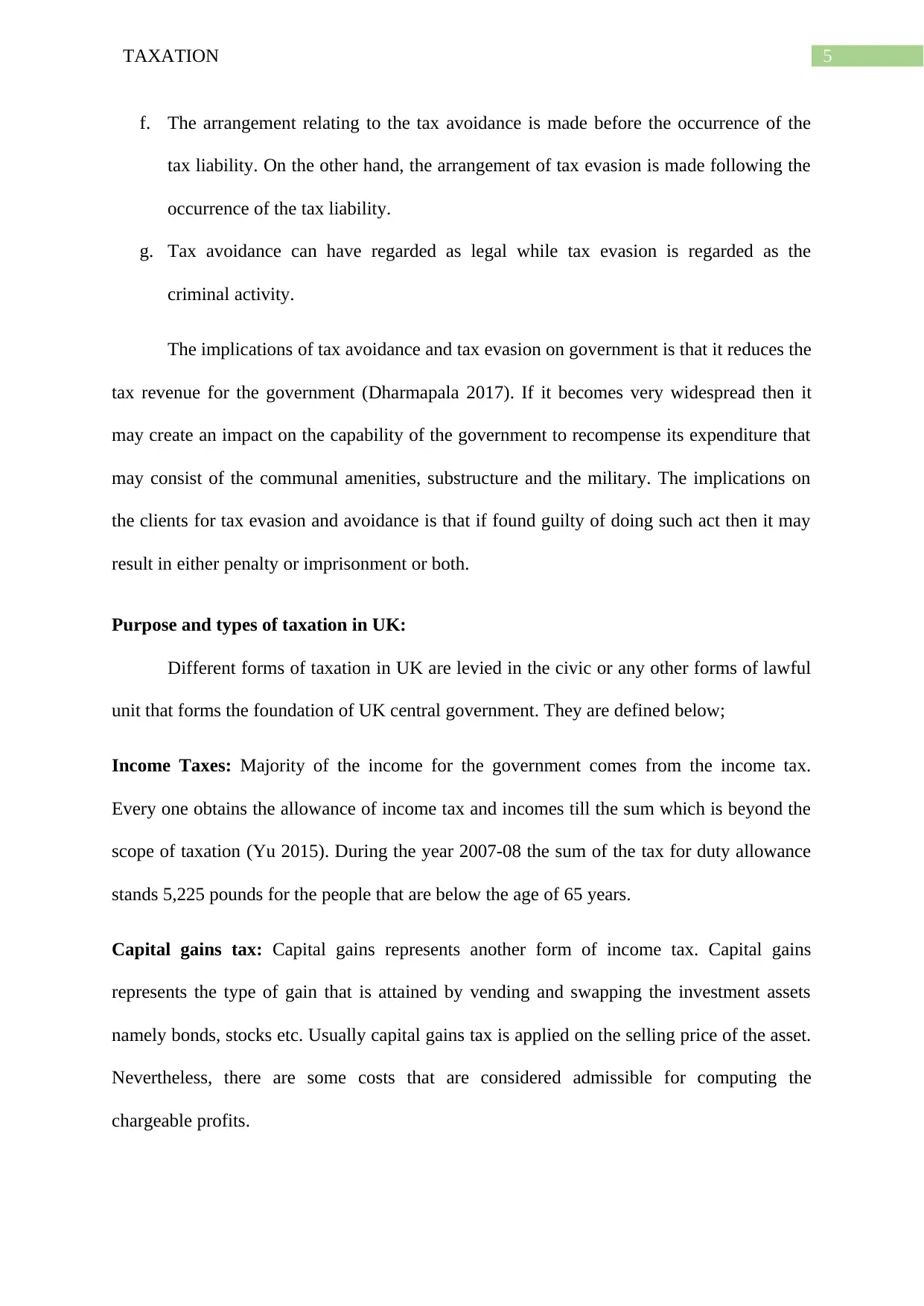
5TAXATION
f. The arrangement relating to the tax avoidance is made before the occurrence of the
tax liability. On the other hand, the arrangement of tax evasion is made following the
occurrence of the tax liability.
g. Tax avoidance can have regarded as legal while tax evasion is regarded as the
criminal activity.
The implications of tax avoidance and tax evasion on government is that it reduces the
tax revenue for the government (Dharmapala 2017). If it becomes very widespread then it
may create an impact on the capability of the government to recompense its expenditure that
may consist of the communal amenities, substructure and the military. The implications on
the clients for tax evasion and avoidance is that if found guilty of doing such act then it may
result in either penalty or imprisonment or both.
Purpose and types of taxation in UK:
Different forms of taxation in UK are levied in the civic or any other forms of lawful
unit that forms the foundation of UK central government. They are defined below;
Income Taxes: Majority of the income for the government comes from the income tax.
Every one obtains the allowance of income tax and incomes till the sum which is beyond the
scope of taxation (Yu 2015). During the year 2007-08 the sum of the tax for duty allowance
stands 5,225 pounds for the people that are below the age of 65 years.
Capital gains tax: Capital gains represents another form of income tax. Capital gains
represents the type of gain that is attained by vending and swapping the investment assets
namely bonds, stocks etc. Usually capital gains tax is applied on the selling price of the asset.
Nevertheless, there are some costs that are considered admissible for computing the
chargeable profits.
f. The arrangement relating to the tax avoidance is made before the occurrence of the
tax liability. On the other hand, the arrangement of tax evasion is made following the
occurrence of the tax liability.
g. Tax avoidance can have regarded as legal while tax evasion is regarded as the
criminal activity.
The implications of tax avoidance and tax evasion on government is that it reduces the
tax revenue for the government (Dharmapala 2017). If it becomes very widespread then it
may create an impact on the capability of the government to recompense its expenditure that
may consist of the communal amenities, substructure and the military. The implications on
the clients for tax evasion and avoidance is that if found guilty of doing such act then it may
result in either penalty or imprisonment or both.
Purpose and types of taxation in UK:
Different forms of taxation in UK are levied in the civic or any other forms of lawful
unit that forms the foundation of UK central government. They are defined below;
Income Taxes: Majority of the income for the government comes from the income tax.
Every one obtains the allowance of income tax and incomes till the sum which is beyond the
scope of taxation (Yu 2015). During the year 2007-08 the sum of the tax for duty allowance
stands 5,225 pounds for the people that are below the age of 65 years.
Capital gains tax: Capital gains represents another form of income tax. Capital gains
represents the type of gain that is attained by vending and swapping the investment assets
namely bonds, stocks etc. Usually capital gains tax is applied on the selling price of the asset.
Nevertheless, there are some costs that are considered admissible for computing the
chargeable profits.
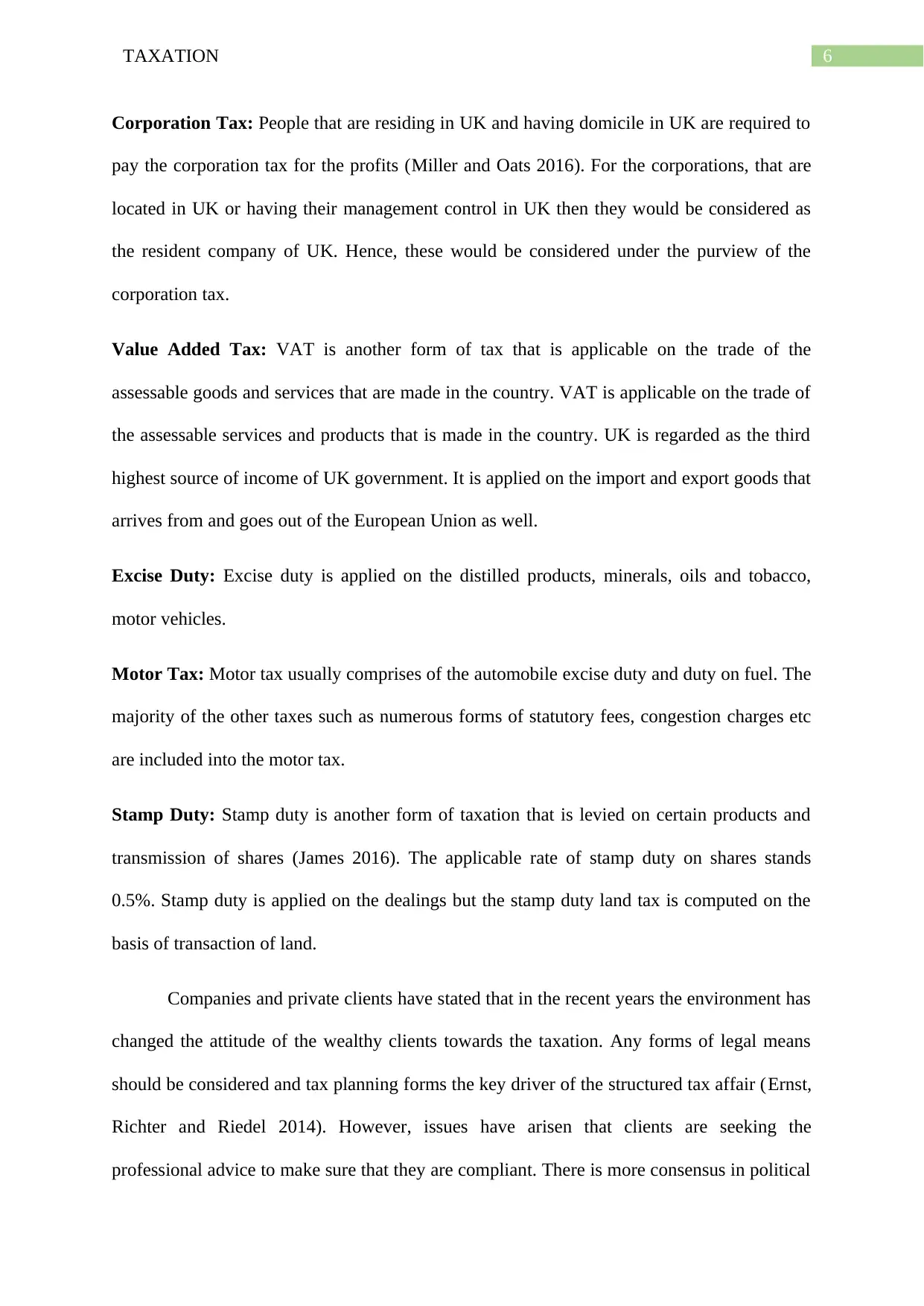
6TAXATION
Corporation Tax: People that are residing in UK and having domicile in UK are required to
pay the corporation tax for the profits (Miller and Oats 2016). For the corporations, that are
located in UK or having their management control in UK then they would be considered as
the resident company of UK. Hence, these would be considered under the purview of the
corporation tax.
Value Added Tax: VAT is another form of tax that is applicable on the trade of the
assessable goods and services that are made in the country. VAT is applicable on the trade of
the assessable services and products that is made in the country. UK is regarded as the third
highest source of income of UK government. It is applied on the import and export goods that
arrives from and goes out of the European Union as well.
Excise Duty: Excise duty is applied on the distilled products, minerals, oils and tobacco,
motor vehicles.
Motor Tax: Motor tax usually comprises of the automobile excise duty and duty on fuel. The
majority of the other taxes such as numerous forms of statutory fees, congestion charges etc
are included into the motor tax.
Stamp Duty: Stamp duty is another form of taxation that is levied on certain products and
transmission of shares (James 2016). The applicable rate of stamp duty on shares stands
0.5%. Stamp duty is applied on the dealings but the stamp duty land tax is computed on the
basis of transaction of land.
Companies and private clients have stated that in the recent years the environment has
changed the attitude of the wealthy clients towards the taxation. Any forms of legal means
should be considered and tax planning forms the key driver of the structured tax affair (Ernst,
Richter and Riedel 2014). However, issues have arisen that clients are seeking the
professional advice to make sure that they are compliant. There is more consensus in political
Corporation Tax: People that are residing in UK and having domicile in UK are required to
pay the corporation tax for the profits (Miller and Oats 2016). For the corporations, that are
located in UK or having their management control in UK then they would be considered as
the resident company of UK. Hence, these would be considered under the purview of the
corporation tax.
Value Added Tax: VAT is another form of tax that is applicable on the trade of the
assessable goods and services that are made in the country. VAT is applicable on the trade of
the assessable services and products that is made in the country. UK is regarded as the third
highest source of income of UK government. It is applied on the import and export goods that
arrives from and goes out of the European Union as well.
Excise Duty: Excise duty is applied on the distilled products, minerals, oils and tobacco,
motor vehicles.
Motor Tax: Motor tax usually comprises of the automobile excise duty and duty on fuel. The
majority of the other taxes such as numerous forms of statutory fees, congestion charges etc
are included into the motor tax.
Stamp Duty: Stamp duty is another form of taxation that is levied on certain products and
transmission of shares (James 2016). The applicable rate of stamp duty on shares stands
0.5%. Stamp duty is applied on the dealings but the stamp duty land tax is computed on the
basis of transaction of land.
Companies and private clients have stated that in the recent years the environment has
changed the attitude of the wealthy clients towards the taxation. Any forms of legal means
should be considered and tax planning forms the key driver of the structured tax affair (Ernst,
Richter and Riedel 2014). However, issues have arisen that clients are seeking the
professional advice to make sure that they are compliant. There is more consensus in political
Paraphrase This Document
Need a fresh take? Get an instant paraphrase of this document with our AI Paraphraser
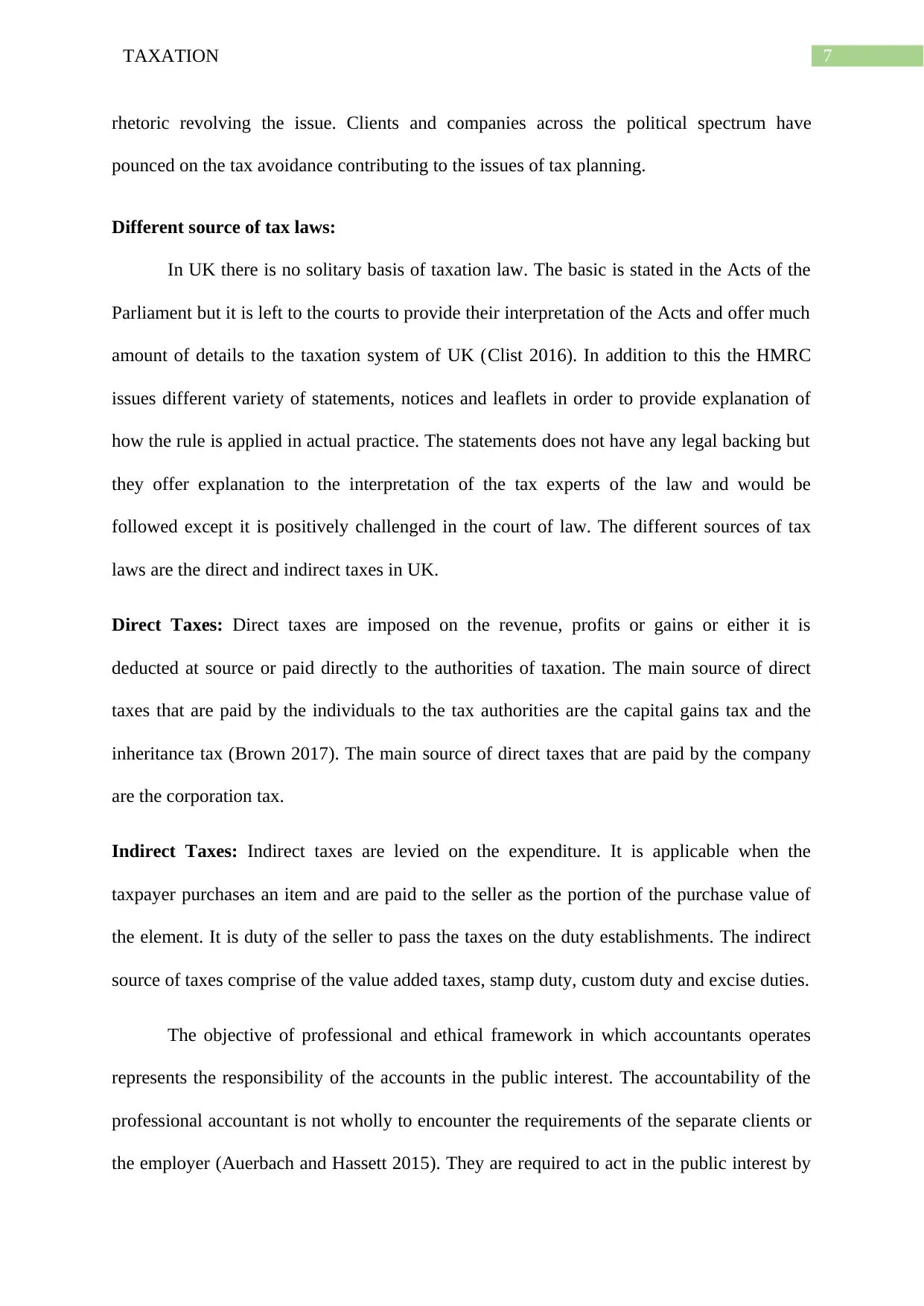
7TAXATION
rhetoric revolving the issue. Clients and companies across the political spectrum have
pounced on the tax avoidance contributing to the issues of tax planning.
Different source of tax laws:
In UK there is no solitary basis of taxation law. The basic is stated in the Acts of the
Parliament but it is left to the courts to provide their interpretation of the Acts and offer much
amount of details to the taxation system of UK (Clist 2016). In addition to this the HMRC
issues different variety of statements, notices and leaflets in order to provide explanation of
how the rule is applied in actual practice. The statements does not have any legal backing but
they offer explanation to the interpretation of the tax experts of the law and would be
followed except it is positively challenged in the court of law. The different sources of tax
laws are the direct and indirect taxes in UK.
Direct Taxes: Direct taxes are imposed on the revenue, profits or gains or either it is
deducted at source or paid directly to the authorities of taxation. The main source of direct
taxes that are paid by the individuals to the tax authorities are the capital gains tax and the
inheritance tax (Brown 2017). The main source of direct taxes that are paid by the company
are the corporation tax.
Indirect Taxes: Indirect taxes are levied on the expenditure. It is applicable when the
taxpayer purchases an item and are paid to the seller as the portion of the purchase value of
the element. It is duty of the seller to pass the taxes on the duty establishments. The indirect
source of taxes comprise of the value added taxes, stamp duty, custom duty and excise duties.
The objective of professional and ethical framework in which accountants operates
represents the responsibility of the accounts in the public interest. The accountability of the
professional accountant is not wholly to encounter the requirements of the separate clients or
the employer (Auerbach and Hassett 2015). They are required to act in the public interest by
rhetoric revolving the issue. Clients and companies across the political spectrum have
pounced on the tax avoidance contributing to the issues of tax planning.
Different source of tax laws:
In UK there is no solitary basis of taxation law. The basic is stated in the Acts of the
Parliament but it is left to the courts to provide their interpretation of the Acts and offer much
amount of details to the taxation system of UK (Clist 2016). In addition to this the HMRC
issues different variety of statements, notices and leaflets in order to provide explanation of
how the rule is applied in actual practice. The statements does not have any legal backing but
they offer explanation to the interpretation of the tax experts of the law and would be
followed except it is positively challenged in the court of law. The different sources of tax
laws are the direct and indirect taxes in UK.
Direct Taxes: Direct taxes are imposed on the revenue, profits or gains or either it is
deducted at source or paid directly to the authorities of taxation. The main source of direct
taxes that are paid by the individuals to the tax authorities are the capital gains tax and the
inheritance tax (Brown 2017). The main source of direct taxes that are paid by the company
are the corporation tax.
Indirect Taxes: Indirect taxes are levied on the expenditure. It is applicable when the
taxpayer purchases an item and are paid to the seller as the portion of the purchase value of
the element. It is duty of the seller to pass the taxes on the duty establishments. The indirect
source of taxes comprise of the value added taxes, stamp duty, custom duty and excise duties.
The objective of professional and ethical framework in which accountants operates
represents the responsibility of the accounts in the public interest. The accountability of the
professional accountant is not wholly to encounter the requirements of the separate clients or
the employer (Auerbach and Hassett 2015). They are required to act in the public interest by
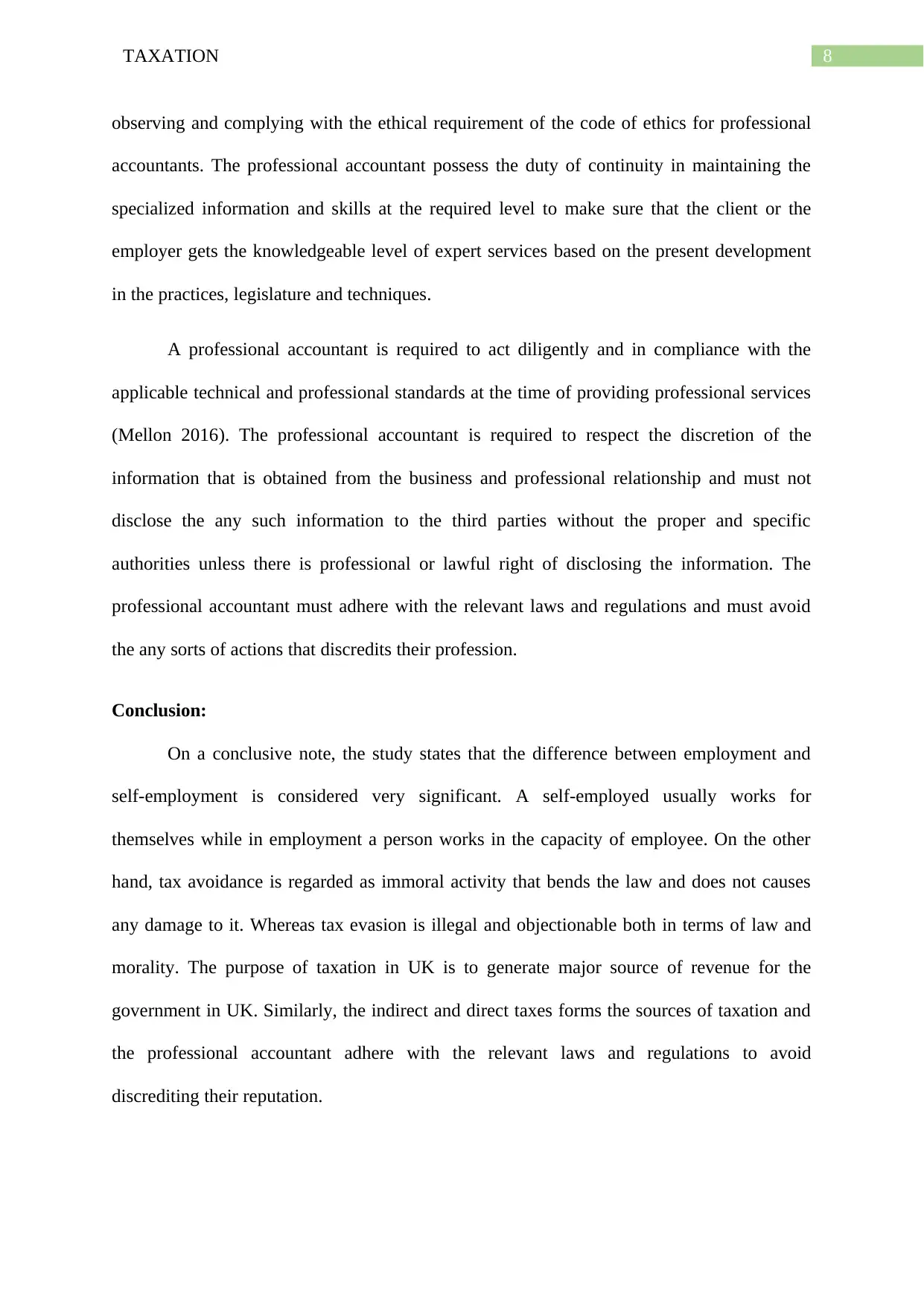
8TAXATION
observing and complying with the ethical requirement of the code of ethics for professional
accountants. The professional accountant possess the duty of continuity in maintaining the
specialized information and skills at the required level to make sure that the client or the
employer gets the knowledgeable level of expert services based on the present development
in the practices, legislature and techniques.
A professional accountant is required to act diligently and in compliance with the
applicable technical and professional standards at the time of providing professional services
(Mellon 2016). The professional accountant is required to respect the discretion of the
information that is obtained from the business and professional relationship and must not
disclose the any such information to the third parties without the proper and specific
authorities unless there is professional or lawful right of disclosing the information. The
professional accountant must adhere with the relevant laws and regulations and must avoid
the any sorts of actions that discredits their profession.
Conclusion:
On a conclusive note, the study states that the difference between employment and
self-employment is considered very significant. A self-employed usually works for
themselves while in employment a person works in the capacity of employee. On the other
hand, tax avoidance is regarded as immoral activity that bends the law and does not causes
any damage to it. Whereas tax evasion is illegal and objectionable both in terms of law and
morality. The purpose of taxation in UK is to generate major source of revenue for the
government in UK. Similarly, the indirect and direct taxes forms the sources of taxation and
the professional accountant adhere with the relevant laws and regulations to avoid
discrediting their reputation.
observing and complying with the ethical requirement of the code of ethics for professional
accountants. The professional accountant possess the duty of continuity in maintaining the
specialized information and skills at the required level to make sure that the client or the
employer gets the knowledgeable level of expert services based on the present development
in the practices, legislature and techniques.
A professional accountant is required to act diligently and in compliance with the
applicable technical and professional standards at the time of providing professional services
(Mellon 2016). The professional accountant is required to respect the discretion of the
information that is obtained from the business and professional relationship and must not
disclose the any such information to the third parties without the proper and specific
authorities unless there is professional or lawful right of disclosing the information. The
professional accountant must adhere with the relevant laws and regulations and must avoid
the any sorts of actions that discredits their profession.
Conclusion:
On a conclusive note, the study states that the difference between employment and
self-employment is considered very significant. A self-employed usually works for
themselves while in employment a person works in the capacity of employee. On the other
hand, tax avoidance is regarded as immoral activity that bends the law and does not causes
any damage to it. Whereas tax evasion is illegal and objectionable both in terms of law and
morality. The purpose of taxation in UK is to generate major source of revenue for the
government in UK. Similarly, the indirect and direct taxes forms the sources of taxation and
the professional accountant adhere with the relevant laws and regulations to avoid
discrediting their reputation.
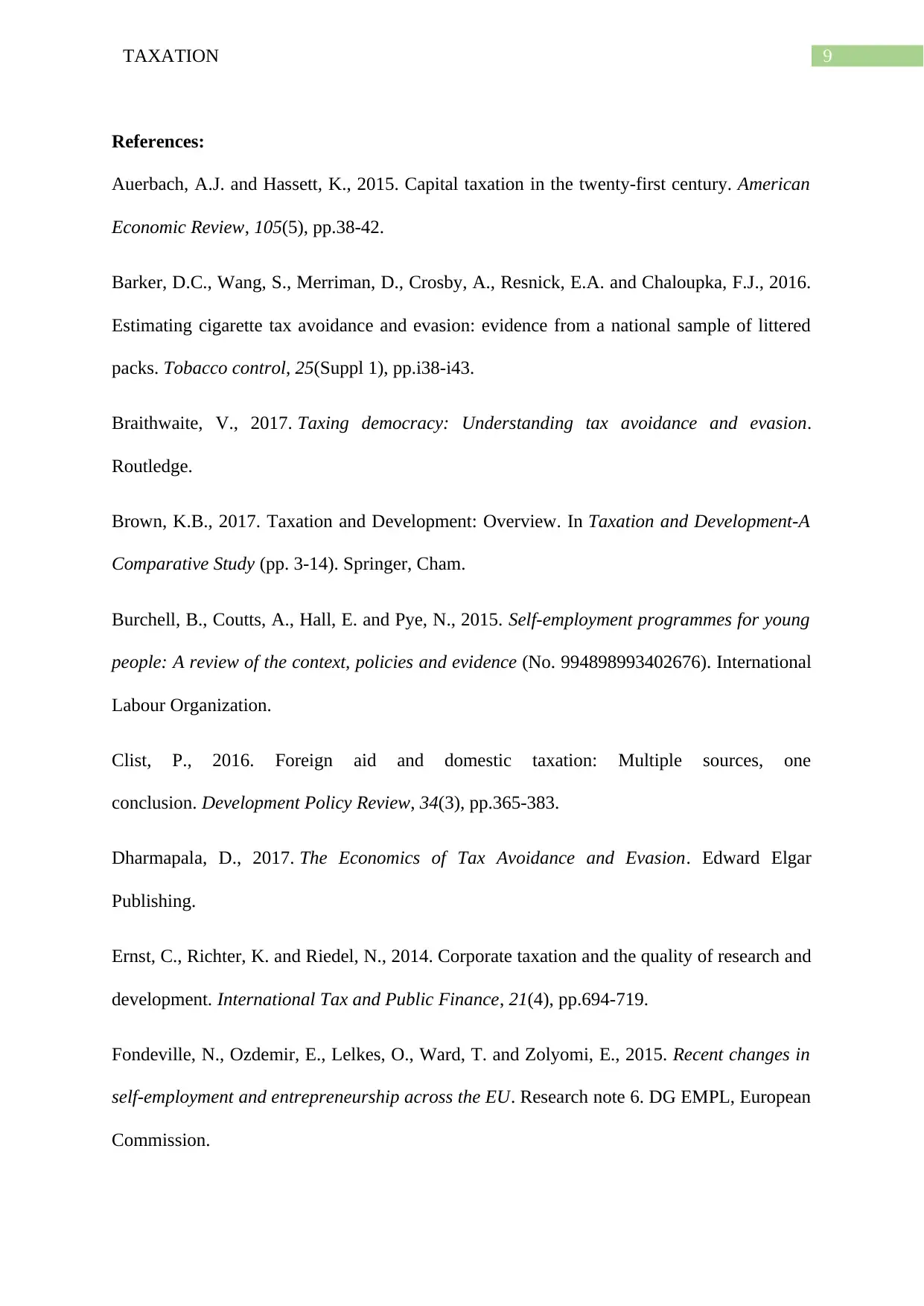
9TAXATION
References:
Auerbach, A.J. and Hassett, K., 2015. Capital taxation in the twenty-first century. American
Economic Review, 105(5), pp.38-42.
Barker, D.C., Wang, S., Merriman, D., Crosby, A., Resnick, E.A. and Chaloupka, F.J., 2016.
Estimating cigarette tax avoidance and evasion: evidence from a national sample of littered
packs. Tobacco control, 25(Suppl 1), pp.i38-i43.
Braithwaite, V., 2017. Taxing democracy: Understanding tax avoidance and evasion.
Routledge.
Brown, K.B., 2017. Taxation and Development: Overview. In Taxation and Development-A
Comparative Study (pp. 3-14). Springer, Cham.
Burchell, B., Coutts, A., Hall, E. and Pye, N., 2015. Self-employment programmes for young
people: A review of the context, policies and evidence (No. 994898993402676). International
Labour Organization.
Clist, P., 2016. Foreign aid and domestic taxation: Multiple sources, one
conclusion. Development Policy Review, 34(3), pp.365-383.
Dharmapala, D., 2017. The Economics of Tax Avoidance and Evasion. Edward Elgar
Publishing.
Ernst, C., Richter, K. and Riedel, N., 2014. Corporate taxation and the quality of research and
development. International Tax and Public Finance, 21(4), pp.694-719.
Fondeville, N., Ozdemir, E., Lelkes, O., Ward, T. and Zolyomi, E., 2015. Recent changes in
self-employment and entrepreneurship across the EU. Research note 6. DG EMPL, European
Commission.
References:
Auerbach, A.J. and Hassett, K., 2015. Capital taxation in the twenty-first century. American
Economic Review, 105(5), pp.38-42.
Barker, D.C., Wang, S., Merriman, D., Crosby, A., Resnick, E.A. and Chaloupka, F.J., 2016.
Estimating cigarette tax avoidance and evasion: evidence from a national sample of littered
packs. Tobacco control, 25(Suppl 1), pp.i38-i43.
Braithwaite, V., 2017. Taxing democracy: Understanding tax avoidance and evasion.
Routledge.
Brown, K.B., 2017. Taxation and Development: Overview. In Taxation and Development-A
Comparative Study (pp. 3-14). Springer, Cham.
Burchell, B., Coutts, A., Hall, E. and Pye, N., 2015. Self-employment programmes for young
people: A review of the context, policies and evidence (No. 994898993402676). International
Labour Organization.
Clist, P., 2016. Foreign aid and domestic taxation: Multiple sources, one
conclusion. Development Policy Review, 34(3), pp.365-383.
Dharmapala, D., 2017. The Economics of Tax Avoidance and Evasion. Edward Elgar
Publishing.
Ernst, C., Richter, K. and Riedel, N., 2014. Corporate taxation and the quality of research and
development. International Tax and Public Finance, 21(4), pp.694-719.
Fondeville, N., Ozdemir, E., Lelkes, O., Ward, T. and Zolyomi, E., 2015. Recent changes in
self-employment and entrepreneurship across the EU. Research note 6. DG EMPL, European
Commission.
Secure Best Marks with AI Grader
Need help grading? Try our AI Grader for instant feedback on your assignments.
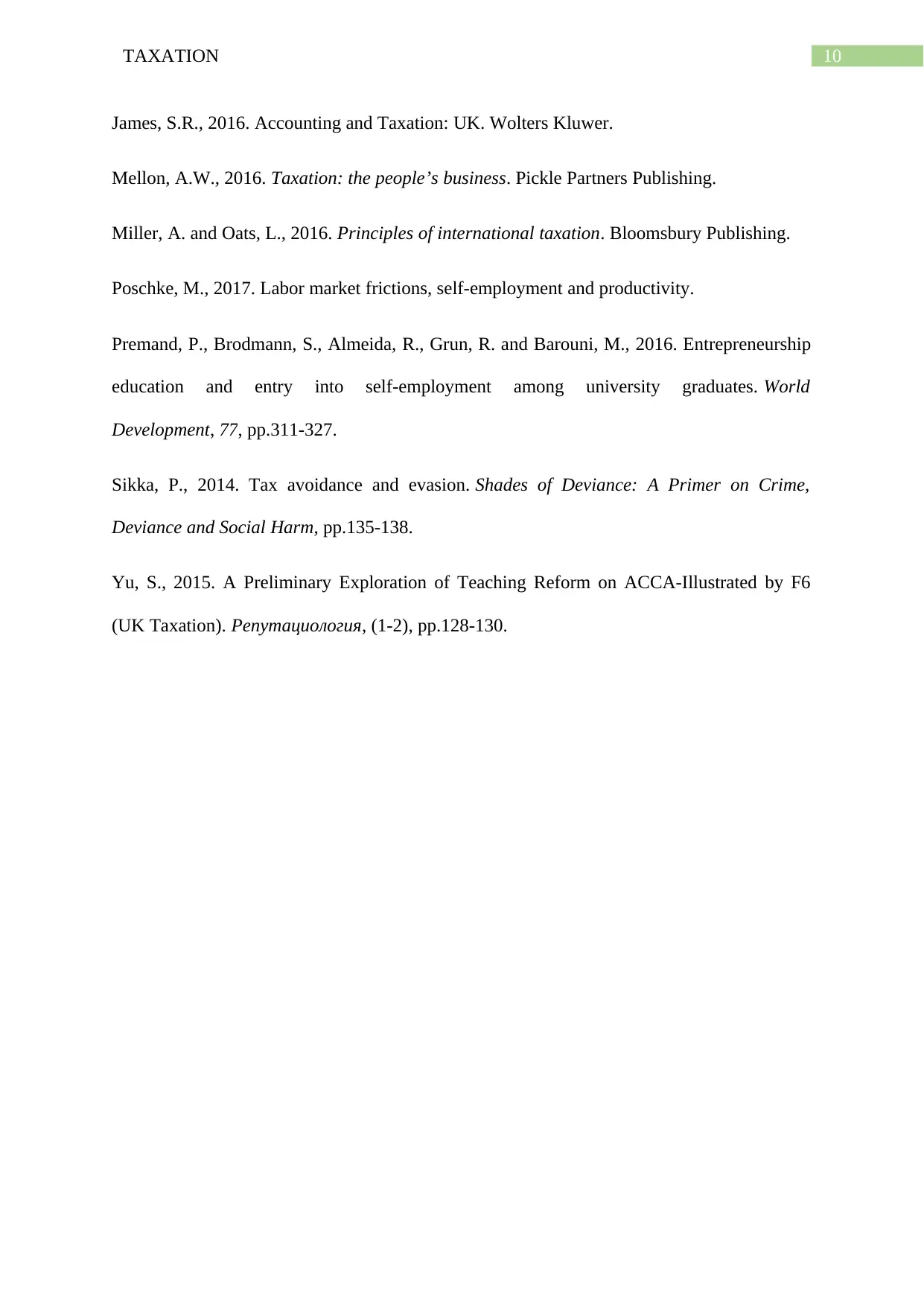
10TAXATION
James, S.R., 2016. Accounting and Taxation: UK. Wolters Kluwer.
Mellon, A.W., 2016. Taxation: the people’s business. Pickle Partners Publishing.
Miller, A. and Oats, L., 2016. Principles of international taxation. Bloomsbury Publishing.
Poschke, M., 2017. Labor market frictions, self-employment and productivity.
Premand, P., Brodmann, S., Almeida, R., Grun, R. and Barouni, M., 2016. Entrepreneurship
education and entry into self-employment among university graduates. World
Development, 77, pp.311-327.
Sikka, P., 2014. Tax avoidance and evasion. Shades of Deviance: A Primer on Crime,
Deviance and Social Harm, pp.135-138.
Yu, S., 2015. A Preliminary Exploration of Teaching Reform on ACCA-Illustrated by F6
(UK Taxation). Репутациология, (1-2), pp.128-130.
James, S.R., 2016. Accounting and Taxation: UK. Wolters Kluwer.
Mellon, A.W., 2016. Taxation: the people’s business. Pickle Partners Publishing.
Miller, A. and Oats, L., 2016. Principles of international taxation. Bloomsbury Publishing.
Poschke, M., 2017. Labor market frictions, self-employment and productivity.
Premand, P., Brodmann, S., Almeida, R., Grun, R. and Barouni, M., 2016. Entrepreneurship
education and entry into self-employment among university graduates. World
Development, 77, pp.311-327.
Sikka, P., 2014. Tax avoidance and evasion. Shades of Deviance: A Primer on Crime,
Deviance and Social Harm, pp.135-138.
Yu, S., 2015. A Preliminary Exploration of Teaching Reform on ACCA-Illustrated by F6
(UK Taxation). Репутациология, (1-2), pp.128-130.
1 out of 11
Related Documents
Your All-in-One AI-Powered Toolkit for Academic Success.
+13062052269
info@desklib.com
Available 24*7 on WhatsApp / Email
![[object Object]](/_next/static/media/star-bottom.7253800d.svg)
Unlock your academic potential
© 2024 | Zucol Services PVT LTD | All rights reserved.





